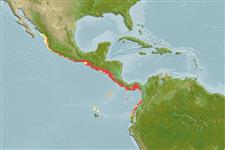Teleostei (teleosts) >
Eupercaria/misc (Various families in series Eupercaria) >
Haemulidae (Grunts) > Haemulinae
Etymology: Haemulopsis: Greek, haimaleos = bloody + Greek, opsis = with appearance (Ref. 45335).
More on author: Steindachner.
Environment: milieu / climate zone / depth range / distribution range
Ecology
Marine; demersal. Tropical; 24°N - 3°S, 108°W - 77°W
Eastern Central Pacific: Mazatlan, Mexico to Ecuador.
Size / Weight / Age
Maturity: Lm ? range ? - ? cm
Max length : 37.0 cm TL male/unsexed; (Ref. 124487); common length : 26.0 cm TL male/unsexed; (Ref. 9114); max. published weight: 779.60 g (Ref. 124487)
Body oblong, compressed, and not very deep (depth contained 2.7 to 3.0 times in standard length); mouth small and terminal mouth, its posterior edge located at the same level as the anterior rim of the eye; first gill arch with 25 to 27 gill rakers; dorsal fin deeply notched, with 12 spines and 14 to 16 soft rays (XII, 14-15); second anal spine longer than third; scale series above lateral line oblique; body silvery gray, with light or dark longitudinal stripes along the series of scales, and with 5 or 6 dark vertical bars; internal side of pectoral fins with a large black spot, scarcely visible when fins folded (Ref. 55763).
Body shape (shape guide): fusiform / normal.
Found on the continental shelf (Ref. 9114). Marketed fresh or reduced to fishmeal (Ref. 9114).
Life cycle and mating behavior
Maturity | Reproduction | Spawning | Eggs | Fecundity | Larvae
Oviparous, distinct pairing during breeding (Ref. 205).
Allen, G.R. and D.R. Robertson, 1994. Fishes of the tropical eastern Pacific. University of Hawaii Press, Honolulu. 332 p. (Ref. 11482)
IUCN Red List Status (Ref. 130435: Version 2025-1)
Threat to humans
Harmless
Human uses
Fisheries: minor commercial
Tools
Special reports
Download XML
Internet sources
Estimates based on models
Preferred temperature (Ref.
123201): 15.9 - 26.2, mean 21.4 °C (based on 32 cells).
Phylogenetic diversity index (Ref.
82804): PD
50 = 0.5312 [Uniqueness, from 0.5 = low to 2.0 = high].
Bayesian length-weight: a=0.01288 (0.01032 - 0.01608), b=2.99 (2.95 - 3.03), in cm total length, based on LWR estimates for this species (Ref.
93245).
Trophic level (Ref.
69278): 3.4 ±0.4 se; based on size and trophs of closest relatives
Resilience (Ref.
120179): Medium, minimum population doubling time 1.4 - 4.4 years (Preliminary K or Fecundity.).
Fishing Vulnerability (Ref.
59153): Low to moderate vulnerability (27 of 100).
🛈
Nutrients (Ref.
124155): Calcium = 159 [34, 317] mg/100g; Iron = 1.15 [0.59, 2.22] mg/100g; Protein = 18.5 [16.6, 20.3] %; Omega3 = 0.232 [0.120, 0.405] g/100g; Selenium = 46.1 [25.5, 86.6] μg/100g; VitaminA = 25.2 [10.1, 59.6] μg/100g; Zinc = 1.23 [0.87, 1.75] mg/100g (wet weight);
